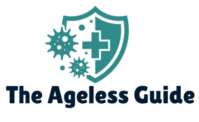Did you know that seniors in the United States spend a large chunk of their income on healthcare each year? It is a staggering amount, which is why mastering healthcare navigation for healthy aging is so important. I put together this guide to make things easier, giving you the knowledge and confidence to make smart choices about your care as you move through retirement.

I will walk you through Medicare, look at extra insurance options, help you find the best doctors and point you to key resources that promote healthcare navigation for healthy aging. My main goal is to equip you with everything you need to thrive during these important years.
Medicare is the base of healthcare coverage for many older adults in America. If you want effective healthcare navigation for healthy aging, you need to understand how Medicare works. Let us break down Medicare’s parts to explain each one.
See today’s best price on Outlive: The Science and Art of Longevity here.
Understanding Medicare Parts A & B for Healthy Aging
Medicare Part A: Hospital Coverage
Part A takes care of inpatient hospital stays, care in skilled nursing facilities, hospice and some healthcare at home. Most people do not pay a monthly premium for Part A if they have worked long enough and paid Medicare taxes for at least 10 years (40 quarters). If you do not meet those requirements, you might be able to purchase Part A coverage.
When you are in the hospital, Part A covers your room, meals, nursing care, lab work, needed medical gear and related items. You will encounter a deductible for each benefit period. That period starts the day you enter a hospital or skilled nursing facility and continues until you have gone 60 days in a row without inpatient or skilled nursing care.
See our expert reviews of the best Creams for Over 50.
Medicare Part B: Medical Coverage
Part B covers visits to the doctor, outpatient services, preventative healthcare and some medical equipment. Most people pay a standard monthly premium for Part B coverage, but the price changes based on income. There is also a deductible each year.
Part B includes many services:
- Regular checkups with your doctor, including visits to specialists
- Preventive screenings such as mammograms and colonoscopies
- Key vaccinations, including shots for the flu and pneumonia
- Medical equipment that lasts, such as wheelchairs and walkers
- Mental health support
- Rehabilitative therapy, both physical and occupational
Explore this top-rated option: Successful Aging here.
Medicare Part C: Medicare Advantage for Enhanced Benefits

Private insurance companies that work with Medicare offer Medicare Advantage plans (MA plans). These plans include all the benefits of Parts A and B and often have extras such as vision, dental and hearing coverage. Many MA plans also cover prescription drugs through Part D.
MA plans come in a few forms:
- Health Maintenance Organizations (HMOs): Typically, you choose a primary care physician who handles your healthcare, coordinates your care and sends you to specialists inside the plan’s network.
- Preferred Provider Organizations (PPOs): You can visit doctors and specialists inside and outside the plan’s network. You generally save money if you use providers within the network.
- Private Fee for Service (PFFS) plans: These plans decide how much they will pay doctors and hospitals. You can go to any provider who accepts what the plan pays.
- Special Needs Plans (SNPs): These plans are made for people with certain long term conditions or special healthcare needs.
Before you sign up, look closely at the details of each MA plan. Think about the provider network, how costs are shared (copays, deductibles and coinsurance) and the benefits included.
Medicare Part D: Prescription Drug Coverage
Part D protects you from the cost of prescription drugs. Private insurers that partner with Medicare run it. You can join a Part D plan on its own or get drug coverage through Medicare Advantage.
Every Part D plan has a formulary, which is a list of drugs it covers. The formulary is broken into tiers, each having different cost sharing rules. Generic drugs are usually in the lower tiers, while brand name drugs are in the higher ones.
Part D has a coverage gap, known as the donut hole. Once you and your plan have spent a certain amount on covered drugs, you enter this gap and pay a higher share of the drug costs. In 2024, once you and your plan spend $5,030 on covered drugs, you pay 25% of the cost until your out of pocket expenses reach $8,000. Then, you enter catastrophic coverage, where you only pay a small coinsurance payment or copay for covered drugs for the rest of the year.
Medigap: Supplemental Insurance for Comprehensive Coverage
Medigap policies, or Medicare Supplement Insurance, are private plans that help pay for the out of pocket costs that Original Medicare (Parts A and B) does not cover. This includes deductibles, coinsurance payments and copays. This coverage is important for effective healthcare navigation for healthy aging.
Medigap policies are standardized. Every plan letter (Plan A, G or N) provides similar core benefits, no matter which insurance company sells it. Premiums can be very different, so shop around to find the best price.
Some Medigap policies have extra benefits, such as coverage for emergency healthcare when traveling outside the country.
Keep in mind that you cannot have a Medigap policy and a Medicare Advantage plan at the same time. If you sign up for Medicare Advantage, Medigap will not be available to cover your cost sharing.
Our complete guide to Top Amazon Brain Health Supplements is right here.
Finding the Right Doctors for Healthy Aging

Keeping a strong relationship with your doctors is key to managing your health as you get older. Here is how to find the right providers for what you need.
Primary Care Physicians
Your primary care physician is your main healthcare contact. They handle routine checkups, preventive care and treatment for common sicknesses. They also work with specialists and other providers to handle your care as a whole.
When picking a primary care physician, think about:
- The doctor’s education and qualifications
- The way they communicate and their bedside manner
- Where their office is located and their hours
- Whether they accept your insurance plan
Ask for recommendations from friends, family or other healthcare providers. You can also use online directories to find primary care physicians near you.
Specialists
Specialists have detailed knowledge about specific parts of medicine, from cardiology to dermatology to neurology. You might need to see a specialist if you have a difficult medical issue or need a certain treatment.
Your primary care physician can send you to a specialist, or you can find one yourself. When searching for a specialist, consider:
- Their experience and qualifications
- What other providers and patients say about them
- Whether they participate with your insurance plan
If you are enrolled in Medicare Advantage or another managed care plan, make sure the specialist is in your plan’s network.
Geriatricians
Geriatricians focus on caring for older adults. They know the health challenges that often come up as people age, including:
- Long term conditions
- Handling multiple medications
- Balance and mobility problems
- Memory problems and dementia
- Incontinence
A geriatrician gives complete care that takes all your health needs into account. They can also work with other providers to coordinate your care and connect you with resources in the community.
If you are an older adult with difficult health problems, seeing a geriatrician could help. Ask your primary care physician to send you to one or visit the American Geriatrics Society’s website to find one.
Cultivating Strong Doctor-Patient Bonds
Once you have found the right doctors, work on making your relationship with them strong. Here is how:
- Come to appointments ready. Bring a list of your medications, note any allergies and write down any questions.
- Be open with your doctors. Share all your symptoms, concerns and lifestyle choices.
- Ask questions if anything is not clear.
- Carefully follow what your doctor tells you to do. Take your medications as directed and go to all follow up appointments.
- Contact your doctor’s office between appointments if you have questions or concerns.
A strong relationship between doctor and patient leads to better health and a better life.
See why The Best Care Possible is a bestseller here.
Essential Healthcare Resources for Seniors

Besides doctors and hospitals, there are many other healthcare resources that can support healthy aging. Let us look at some of the key options.
Area Agencies on Aging
Area Agencies on Aging are local groups that provide services and support for older adults and their caregivers. They can connect you with services such as:
- Information and referrals
- Care management
- Care at home
- Transportation
- Meals on Wheels
- Senior centers
- Legal aid
- Respite care
Area Agencies on Aging can help you with healthcare and connect you to other resources in the community.
To find your local Area Agency on Aging, go to the Eldercare Locator website or call 1 800 677 1116.
Senior Centers
Senior centers are community centers that offer programs and services for older adults. They provide chances for:
- Social connections
- Recreational activities
- Educational programs
- Health and wellness activities
- Volunteer opportunities
- Shared meals
Senior centers allow you to stay active and connected in your community.
To find a senior center near you, contact your local Area Agency on Aging or check the National Council on Aging’s website.
Looking for the best? Start with our top picks for Under Desk Elliptical Machine for Seniors.
At-Home Healthcare Services

These services give medical care and support in your home. They include:
- Skilled nursing care
- Physical therapy
- Occupational therapy
- Speech therapy
- Home health aides
- Medical social work
Healthcare at home helps with recovery after you have been sick or hurt. It can also help you handle long term conditions or allow you to stay independent in your home. My grandmother really benefited from a home health aide after she had hip replacement surgery. It let her recover in her own home.
Medicare covers some healthcare at home, but there are rules you must meet. You must be under a doctor’s care, have a care plan and be considered homebound. Private insurance and Medicaid may also cover these services.
Hospice
Hospice gives comfort and support to people who are facing a terminal sickness. It focuses on relieving pain and symptoms and making life better. Hospice services can happen at home, in a special facility or in a hospital.
Hospice care usually includes:
- Medical care
- Pain management
- Emotional and spiritual support
- Counseling for family members
- Respite for caregivers
Medicare covers hospice care for people who have a terminal sickness and are expected to live for six months or less. Private insurance and Medicaid may also cover hospice.
Mental Health Services
Your mental health is just as important as your physical health. If you are struggling with worry, sadness or other mental health conditions, get help. Some services that are available:
- Therapy
- Medication management
- Support groups
- Inpatient psychiatric options
Medicare covers some mental health services, but there might be limits. Private insurance and Medicaid can also provide coverage.
Find mental health providers through your insurance carrier, your primary care physician or online directories.
Get the insider’s guide to Best Face Creams for Over 50 here.
Financial Aid Programs

Healthcare can be expensive, especially for older adults who have a fixed income. There are programs that can help with these costs.
- Medicare Savings Programs (MSPs): These programs help people who have limited income and resources handle Medicare premiums and cost sharing.
- Extra Help: This program, also known as the Low Income Subsidy, helps people who have limited income and resources with Part D prescription drug costs.
- State Pharmaceutical Assistance Programs (SPAPs): These programs help with prescription drug costs. What you must do to be eligible changes by state.
- Patient Assistance Programs (PAPs): Drug makers offer these programs to help people with their medication costs.
- Charitable organizations: Many charitable groups offer financial help for healthcare costs.
Learn more about these programs through your local Area Agency on Aging, your state’s Medicaid agency or the BenefitsCheckUp website.
Caregiver Resources
Millions of people give unpaid care to people they love. Caregiving can feel rewarding, but it can also bring stress.
These resources can help you with caregiving:
- The Family Caregiver Alliance (FCA) provides information, education and support.
- The National Alliance for Caregiving (NAC) does research and supports family caregivers.
- The Alzheimer’s Association provides information and support for people who have Alzheimer’s and their caregivers.
- Respite care gives caregivers time off to rest.
Taking care of yourself is key when you are a caregiver. Make sure you get enough sleep, eat well, exercise and take breaks.
— IMAGE_PLACEHOLDER: [A senior woman smiling while talking with a doctor. Alt Text: Senior woman consulting with her doctor.] —
Find The Gift of Years: Growing Older Gracefully on Amazon and see what others are saying here.
Addressing Common Healthcare Challenges for Seniors

As people age, healthcare challenges come up that need special ways to handle them. Here are some examples:
Managing Long-Term Conditions
Many older adults have one or more long term conditions, from heart disease and diabetes to arthritis and chronic obstructive pulmonary disease (COPD). Handling these conditions needs a complete approach that includes:
- Regular checkups with your healthcare provider
- Taking medications as directed
- Eating healthy
- Exercising
- Watching your symptoms
- Going to self management programs
Work with your healthcare team to come up with a care plan that fits what you need.
Preventing Falls
Falls are a main cause of injury and death among older adults. Many falls can be stopped. Here are steps you can take to lower your risk:
- Exercise to make your strength and balance better.
- Have your vision and hearing checked regularly.
- Go over your medications with your doctor or pharmacist to find any that might raise your risk of falling.
- Change your home to make it safer by securing rugs, removing clutter and improving lighting.
- Use devices that help, such as walkers or canes, if you need them.
If you have fallen before, speak with your doctor about having your risk of falling assessed.
Tackling Memory Problems

Memory loss is a common worry as people age. Some memory loss is normal, but it could mean there is a bigger problem, such as Alzheimer’s disease or another kind of dementia.
If you are worried about your memory, see your doctor. They can do a cognitive assessment to check your memory and thinking. If they need to, they might send you to a specialist to be checked further.
These steps can keep your brain healthy as you get older:
- Keep your mind active by reading, doing puzzles or learning new things.
- Stay connected with friends and family.
- Exercise.
- Eat nutritious food.
- Get enough sleep.
- Handle stress.
Pain Management
Pain is a common issue for older adults. It can be caused by many things, including arthritis, nerve damage or injuries.
If you have pain that lasts, talk to your doctor. They can help you make a plan to handle the pain that might include:
- Medications
- Physical therapy
- Occupational therapy
- Injections
- Other therapies, such as acupuncture or massage
Finding a way to handle pain that works for you and lets you live your life is important.
Planning for the End
This planning is important for healthcare as people age. It means making choices about what you want for healthcare in the future and telling your family and healthcare team about those choices.
This planning can include:
- Advance directives: These are legal papers that let you say what you want for your healthcare. This includes living wills and durable power of attorney for healthcare.
- Living will: This paper lets you say what medical treatments you want or do not want if you cannot make choices yourself.
- Durable power of attorney for healthcare: This paper lets you name someone to make healthcare choices for you if you cannot do it.
- Physician Orders for Life Sustaining Treatment (POLST) form: This medical order says what you want regarding certain treatments such as CPR, mechanical ventilation and artificial nutrition and hydration.
- Funeral arrangements: If you complete these plans early, your family will not have to make them when they are having a hard time.
Speaking with your family and healthcare providers about these choices is important to make sure they are followed.
Want more options? Explore our full list of Books on Healthy Aging And Longevity.
The Future of Healthcare Navigation for Healthy Aging

Healthcare is changing because of technology, which is bringing new tools and resources for older adults to handle their health. Telehealth lets you speak with doctors without being in the same place, which helps people who cannot move easily or who live far away. Wearable devices watch vital signs and how active you are, giving data for patients and their providers.
Online portals let you see medical records, make appointments and speak with healthcare teams. Support and training in how to use these tools is important.
— IMAGE_PLACEHOLDER: [A senior man using a tablet with a healthcare app. Alt Text: Senior man using telehealth on a tablet.] —
Preventive care is the basis for keeping your health as you age. Regular checkups, screenings and shots help catch health problems early, when they can often be treated more easily. Preventive care includes things such as:
- Yearly physicals
- Shots, including those for the flu, pneumonia and shingles
- Cancer screenings, such as mammograms, colonoscopies and prostate exams
- Screenings for heart disease, diabetes and other long term conditions
- Vision and hearing tests
- Dental exams
Speak with your doctor about which preventive care services are right for you. Medicare often covers many of these services.
Healthcare can be confusing. It is important to stand up for yourself to get the best care. That means staying informed, asking questions and saying what you need clearly. If you are worried about a diagnosis, treatment or medication, get another opinion. Keep detailed records of your medical history, medications and appointments. That information is valuable when you speak with healthcare providers.
If you feel your worries are not being heard, bring a family member or friend to appointments for support. They can help you remember details, ask for things to be made clearer and make sure you are heard. Remember, you have the right to be part of the choices that are made about your healthcare.

Long term care includes the services and support that people who cannot do everyday tasks on their own need. These services can be given in different places:
- Your home
- Assisted living communities
- Nursing homes
Planning for long term care means thinking about what you might need, looking at your options and planning how to pay for care.
Medicare usually does not cover most long term care services. Medicaid might cover some services for people who have limited income and resources. Private long term care insurance can also help pay for these costs.
Start planning your long term care strategy long before you think you will need it. Speak with your family and a financial advisor about your options.
Healthcare for older adults will probably be shaped by these things:
- More use of technology: Telehealth, wearable devices and online portals will become even more important.
- More focus on preventive care: Healthcare providers will focus more on preventive care to help older adults stay healthy and independent longer.
- Personalized medicine: Healthcare will become more personalized, with treatments made for each person’s needs.
- Better care coordination: Healthcare groups will work together more to coordinate care for older adults who have difficult health issues.
- More care at home: More older adults will be able to get care in their homes.
These things can make life better for older adults and make healthcare easier to get and easier to pay for.
Healthcare can feel hard to handle, but the right knowledge and resources can help you handle your health. If you learn about Medicare, find the right doctors, use the resources that are there and stand up for yourself, you can be sure you are getting the best care. Remember that taking care of your health is something you do all your life. Stay informed, take the first step and make your health a priority. Good healthcare navigation for healthy aging is key to having a good retirement.
Don’t buy Astaxanthin before reading this guide.
Check out this highly recommended product — The 36-Hour Day: A Family Guide to Caring for People Who Have Alzheimer Disease and Other Dementias here







